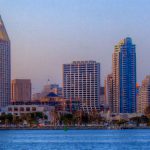What is San Diego Doing to Fix Its Roads?

It’s no secret that driving in San Diego can be dangerous. Although the natural sunny hillsides provide iconic scenery, the beautiful landscape also makes driving extremely difficult.
Preparing for treacherous road conditions in ways like making a list of roadside assistance companies is smart. However, needing to do so before moving or visiting can really put a damper on the excitement of experiencing a new city.
Whether you’re a long-time resident, new resident, or just a visitor, the road conditions of San Diego weren’t likely to make your good list.
When did this problem become so bad, and what is the city doing to fix it? If you’ve been wondering how drivers can better prepare for everyday driving in rough road cities, this article is for you.
Why are San Diego roads so bad?
When we talk about San Diego roads being dreadful, we don’t only mean the bothersome traffic, which in itself is pretty bad. Although traffic is a common complaint of anyone who lives in a big city, matters only worsen when crowded roads are riddled with potholes and roadblocks.
According to TRIP, a national transportation research group, San Diego drivers spend nearly $2,000 a year because of deteriorating and congested roads. In fact, rough road conditions and inadequate infrastructure contribute to wasted time on the road and are key reasons drivers spend unnecessary money on their cars.
How does San Diego weather affect the road conditions?
San Diego has a beautiful climate that makes the city optimal for living and tourism, but cold states aren’t the only ones with road issues.
Many people might assume that cities like San Diego don’t experience extreme weather conditions like snow that may cause strain on the roads. However, between the dry heat, sun, rain, and the commonality of earthquakes, San Diego roads need just as much care.
The ideal California weather begins to have cons when analyzing how the sun and heat encourage erosion on the roads. Dry heat tends to create small cracks and make roadways more susceptible to brittleness.
Brittle roads increase risks of danger for drivers and motorists while allowing further damage from otherwise mild weather. Moreover, the small cracks created by the heat and dry climate only become intensified by frequent earthquakes.
Most people who live in California are no stranger to earthquakes, as most counties within the state experience them. Although most earthquakes are on the smaller side of the Richter scale, each one has the potential to cause damage to the roads of San Diego.
Within San Diego County, most residents live within 15 miles of an area that historically experiences damaging earthquakes. The small cracks created by the heat and earthquakes may not seem like much initially, but they make the roads considerably more vulnerable.
The rainy season in San Diego is between November and March, making the roads constantly undergo conditions that weaken their durability. In addition, rain and wind create hazardous roadway conditions by adding to the debris on the road.
Storms that blow trash, branches, and other particles onto roadways present direct, immediate dangers for drivers. In addition to that, the rain gets into cement and asphalt, causing erosion and extreme roadway damage.
Road debris, rubble, cracks, and erosion affect road conditions by:
- Increasing the likelihood of accidents and speeding
- Adding to excessive wear and tear to vehicles
- Weakening tire traction
- Increasing the chance of wheel ruts
- Resulting in uneven roadways
- Causing extensive road damage in potholes and shoulder drop-offs
These issues can be seen across the city, from the San Diego Zoo to the coast, but natural causes are hard to avoid. Unfortunately, getting frustrated with road conditions comes with living in a major city, but thankfully, San Diego County has been putting tremendous effort into fixing its roads.
The “Sexy Streets” of San Diego
If you’re a local, listening in on infrastructure meetings is both entertaining and informative. For example, in the proposed budget report for 2022, city representatives stated that every neighborhood in San Diego deserves “sexy streets.”
The initiative includes the use of slurry seal, a thin asphalt coat that fills small cracks and road imperfections, to give the street a smooth texture and uniform look. The seal will be used to completely make over and reconstruct underserved roads as well to maintain the roads in good standing condition.
Slurry seal is one of the most cost-effective options for immediate maintenance and extending the life of a road. Adding a slurry seal to the pavement protects the road from erosion caused by weather and everyday wear and tear.
According to the City of San Diego Fiscal Year 2022 Proposed Budget, the “Sexy Streets for All of Us” initiative is “a down payment in our communities of concern.” It’s a $10 million investment in historically underserved neighborhoods that haven’t seen quality road repairs for years.
Funding will go toward paving weathered roads with new overlay and road reconstruction in communities of concern. “Sexy Streets” will also include improvements such as new sidewalk connections, necessary sidewalk repairs, new and upgraded bicycle infrastructure, and investments in the stormwater system.
Increasing support for the roads and public transportation is also supporting and collaborating with the efforts to assist marginalized communities and go green.
Calling these efforts an “essential step towards righting historic wrongs” for marginalized and underinvested communities, San Diego representatives acknowledge that road and transportation conditions are financial and social problems.
As of now, this plan is pending complete approval but would be an active stride in obtaining sustainable infrastructure needed to meet the city’s needs and climate action plan goals.
Plans for change in the right direction seem promising, but government spending historically has favored new construction. Even though we all love to see new flourishing businesses emerge in beloved areas, new construction often creates hazardous traffic conditions and distracts from needed routine maintenance.
After the COVID-19 pandemic displaced and further disenfranchised many communities, efforts to restore and maintain them are refreshing to see. With quarantine efforts hindering more than tourism and San Diego vacation rental sales, many cities can follow San Diego’s lead.
How do I report dangerous road conditions in San Diego?
Creating a road improvement plan that focuses on regaining a sense of normalcy while improving old issues will generate a post-pandemic bounce for the San Diego community.
Keep up with your local area or the place you wish to visit by going to the San Diego City website. You can read city proposals, join town hall meetings, or even report dangerous road conditions at https://streets.sandiego.gov/.
San Diego has always been a city of pride, excitement, and wonder. Initiatives for more substantial infrastructure will only make a great city better.
About the author: Danielle Beck-Hunter writes and researches for the auto insurance comparison site, 4AutoInsuranceQuote.com. Danielle is a California native and fondly remembers the City of San Diego.





